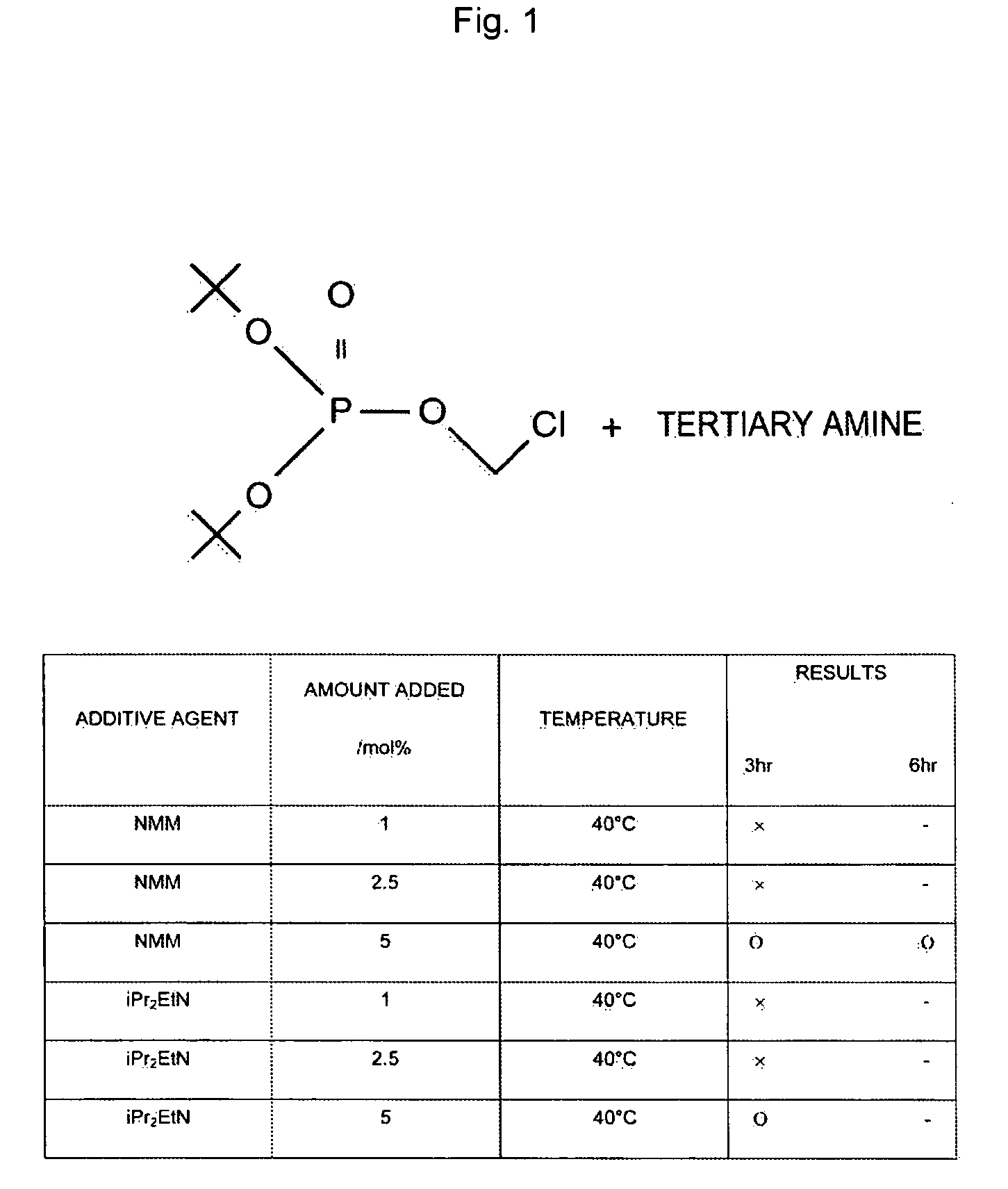Composition Containing Stability-Improved Chloromethyl Phosphate Derivatve and Process for Producing Same
a technology of chloromethyl phosphate and derivatve, which is applied in the field of chloromethyl phosphate derivatives, can solve the problems of limited drug use, difficult industrial production of water-soluble azole compounds, and significant environmental burden
- Summary
- Abstract
- Description
- Claims
- Application Information
AI Technical Summary
Benefits of technology
Problems solved by technology
Method used
Image
Examples
example 1
[0063]
[0064]Paraformaldehyde (10 g) was added to a 100 mL four-neck flask and stirred in an ice-cooled water bath. Chlorosulfonic acid (24 mL) was added thereto dropwise at an internal temperature of 80° C. or lower, and after stirring at room temperature for one hour, thionyl chloride (22 mL) was added thereto dropwise. After termination of the dropwise addition, the reaction solution was heated at 60° C. for three hours, and then cooled. The reaction solution was added dropwise to ice water (400 mL), and liquid separation was carried out. After washing with water, MgSO4 was added to the organic layer, dilution was carried out with the same amount of hexane as the organic layer, and filtration was carried out. The filtrate was concentrated under a reduced pressure, resulting residue was distilled under a reduced pressure to obtain 15 g of the title compound as a colorless clear liquid. (BP: 50 to 60° C. / 18 to 20 mmHg) (yield: 30%)
example 2
[0065]
[0066]Paraformaldehyde (10 g) was added to a 200 mL four-neck flask and stirred in an ice-cooled water bath. Thionyl chloride (22 mL) was added thereto dropwise, and then, chlorosulfonic acid (24 mL) was added thereto dropwise. After stirring at room temperature for four hours, the reaction solution was heated at 60° C. for 14 hours, and then cooled. The reaction solution was added dropwise to ice water (400 mL), and liquid separation was carried out. After washing with water, MgSO4 was added to the organic layer, dilution was carried out with the same amount of hexane as the organic layer, and filtration was carried out. After concentration under a reduced pressure, the resulting residue was distilled under a reduced pressure to obtain 7.9 g of the title compound as a colorless clear liquid. (BP: 54° C. / 15 mmHg) (yield: 16%)
example 3
[0067]
[0068]A 500 mL four-neck round bottom flask was equipped with a mechanical stirrer and a thermometer; under a nitrogen streaming, potassium di-tert-butyl phosphate (24 g), dipotassium hydrogen phosphate (66.3 g), tetrabutylammonium hydrogen sulfate (3.23 g), tert-butyl methyl ether (112 mL) and water (84 mL) were added, and stirred while cooling with an ice bath. At an internal temperature of 15° C., a solution of chloromethyl chlorosulfonate (23.5 g) dissolved in tert-butyl methyl ether (23.6 mL) was added thereto dropwise over two hours at an internal temperature of 30° C. or lower. After dropwise addition was terminated, stirring was carried out for two hours, water (84 mL) and tert-butyl methyl ether (112 mL) were added to a separating funnel, and the above-mentioned reaction solution was added thereto. The lower layer was discarded the organic layer was washed with an aqueous solution of 2M dipotassium hydrogen phosphate (84 mL), an aqueous solution of N-methylmorpholine ...
PUM
| Property | Measurement | Unit |
|---|---|---|
| mol % | aaaaa | aaaaa |
| temperature | aaaaa | aaaaa |
| temperature | aaaaa | aaaaa |
Abstract
Description
Claims
Application Information
 Login to View More
Login to View More - R&D
- Intellectual Property
- Life Sciences
- Materials
- Tech Scout
- Unparalleled Data Quality
- Higher Quality Content
- 60% Fewer Hallucinations
Browse by: Latest US Patents, China's latest patents, Technical Efficacy Thesaurus, Application Domain, Technology Topic, Popular Technical Reports.
© 2025 PatSnap. All rights reserved.Legal|Privacy policy|Modern Slavery Act Transparency Statement|Sitemap|About US| Contact US: help@patsnap.com



